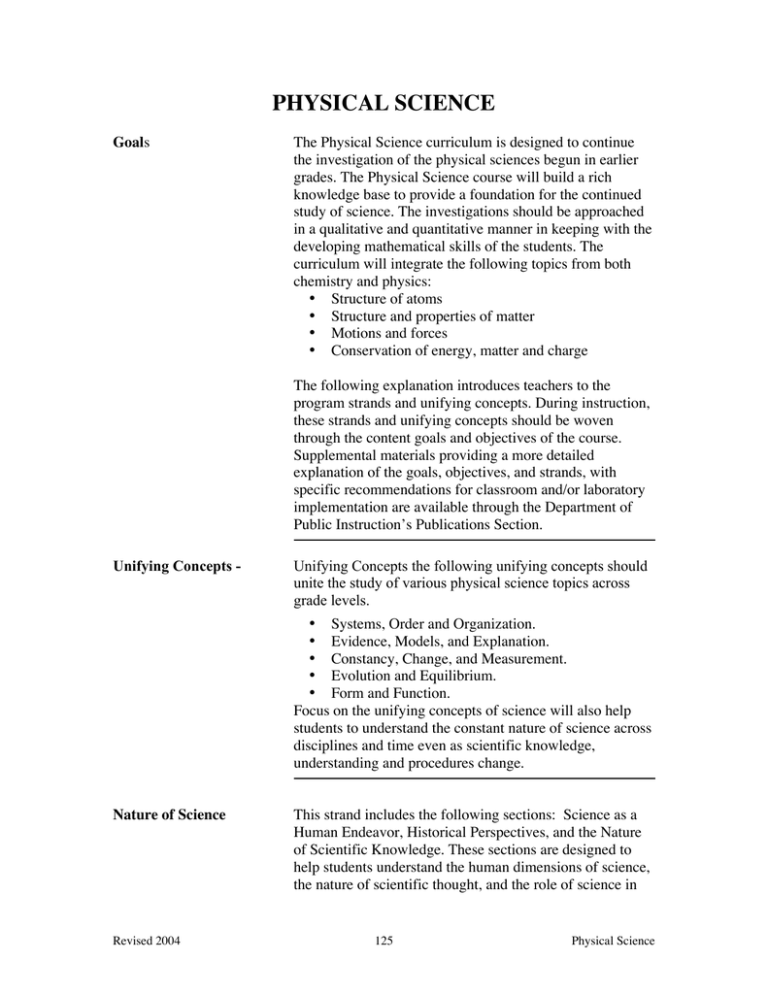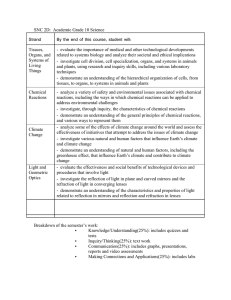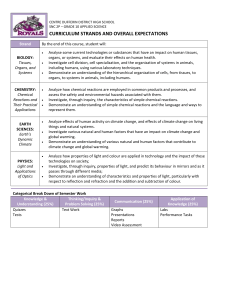Physical Science PDF
advertisement

PHYSICAL SCIENCE Goals The Physical Science curriculum is designed to continue the investigation of the physical sciences begun in earlier grades. The Physical Science course will build a rich knowledge base to provide a foundation for the continued study of science. The investigations should be approached in a qualitative and quantitative manner in keeping with the developing mathematical skills of the students. The curriculum will integrate the following topics from both chemistry and physics: • Structure of atoms • Structure and properties of matter • Motions and forces • Conservation of energy, matter and charge The following explanation introduces teachers to the program strands and unifying concepts. During instruction, these strands and unifying concepts should be woven through the content goals and objectives of the course. Supplemental materials providing a more detailed explanation of the goals, objectives, and strands, with specific recommendations for classroom and/or laboratory implementation are available through the Department of Public Instruction’s Publications Section. Unifying Concepts - Unifying Concepts the following unifying concepts should unite the study of various physical science topics across grade levels. • Systems, Order and Organization. • Evidence, Models, and Explanation. • Constancy, Change, and Measurement. • Evolution and Equilibrium. • Form and Function. Focus on the unifying concepts of science will also help students to understand the constant nature of science across disciplines and time even as scientific knowledge, understanding and procedures change. Nature of Science Revised 2004 This strand includes the following sections: Science as a Human Endeavor, Historical Perspectives, and the Nature of Scientific Knowledge. These sections are designed to help students understand the human dimensions of science, the nature of scientific thought, and the role of science in 125 Physical Science society. Physical science is rich in examples of science as a human endeavor, historical perspectives on the development of scientific understanding, and the nature and role of science. Science as a Human Endeavor Intellectual honesty and an ethical tradition are hallmarks of the practice of science. The practice is rooted in accurate data reporting, peer review, and making findings public. This aspect of the nature of science can be implemented by designing instruction that encourages students to work collaboratively in groups to design investigations, formulate hypotheses, collect data, reach conclusions, and present their findings to their classmates. The content studied in physical science is an opportunity to present science as a basis for engineering, electronics, computer science, astronomy and the technical trades. The diversity of physical science content allows for looking at science as a vocation. Scientist, artist, and technician are just a few of the many careers in which a physical science background is necessary. Perhaps the most important aspect of this strand is that science is an integral part of society and is therefore relevant to students’ lives. Historical Perspectives Revised 2004 Most scientific knowledge and technological advances develop incrementally from the labors of scientists and inventors. Although science history includes accounts of serendipitous scientific discoveries, most development of scientific concepts and technological innovation occurs in response to a specific problem or conflict. Both great advances and gradual knowledge building in science and technology have profound effects on society. Students should appreciate the scientific thought and effort of the individuals who contributed to these advances. Galileo’s struggle to correct the misconceptions arising from Aristotle’s explanation of the behavior of falling bodies led to Newton’s deductive approach to motion in The Principia. Today, Newton’s Law of Universal Gravitation and his laws of motion are used to predict the landing sites for NASA’s space flights. 126 Physical Science Nature of Scientific Knowledge Much of what is understood about the nature of science must be addressed explicitly: • All scientific knowledge is tentative, although many ideas have stood the test of time and are reliable for our use. • Theories "explain" phenomena that we observe. They are never proved; rather, they represent the most logical explanation based on currently available evidence. Theories just become stronger as more supporting evidence is gathered. They provide a context for further research and give us a basis for prediction. For example, in physical science, atomic theory explains the behavior of matter based on the existence of tiny particles. And kinetic theory explains, among other things, the expansion and contraction of gases. • Laws are fundamentally different from theories. They are universal generalizations based on observations of the natural world, such as the nature of gravity, the relationship of forces and motion, and the nature of planetary movement. • Scientists, in their quest for the best explanations of natural phenomena, employ rigorous methods. Scientific explanations must adhere to the rules of evidence, make predictions, be logical, and be consistent with observations and conclusions. The NSES state "Explanations of how the natural world changes based on myths, personal beliefs, religious values, mystical inspiration, superstition, or authority may be personally useful and socially relevant, but they are not scientific." (p. 201). Science as Inquiry Inquiry should be the central theme in physical science. It is an integral part of the learning experience and may be used in both traditional class problems and laboratory work. The essence of the inquiry process is to ask questions that stimulate students to think critically and to formulate their own questions. Observing, classifying, using numbers, plotting graphs, measuring, inferring, predicting, formulating models, interpreting data, hypothesizing, and experimenting all help students to build knowledge and communicate what they have learned. Inquiry is the application of creative thinking to new and unfamiliar situations. Students should learn to design solutions to Revised 2004 127 Physical Science problems that interest them. This may be accomplished in a variety of ways, but situations that present a discrepant event or ones that challenge students’ intuitions have been successful. Classical experiments such as measuring inertia and the speed of falling bodies need not be excluded. Rather, they should be a prelude to open-ended investigations in which the students have the chance to pose questions, design experiments, record and analyze data, and communicate their findings. For example, after measuring the relationships among force, mass, and acceleration of falling bodies, students might investigate the phenomenon of "weightlessness", or, after measuring physical properties, they might investigate the connection (if any) between the density of certain liquids and their boiling point. Although original student research is often relegated to a yearly science fair project, continuing student involvement in research contributes immensely to their understanding of the process of science and to their problem-solving abilities. Physical science provides much potential for inquiries. "Does the aluminum baseball bat have an advantage over a wooden baseball bat?" "Why?" "Is one brand of golf ball better than another brand?" "Why?" The processes of inquiry, experimental design, investigation, and analysis are as important as finding the correct answer. Students will master much more than facts and acquisition of manipulative skills; they will learn to be critical thinkers. A solid conceptual base of scientific principles, as well as knowledge of science safety, is necessary for inquiry. Students should be given a supportive learning environment based on how scientists and engineers work. Adherence to all science safety criteria and guidelines for classroom, field, and laboratory experiences is imperative. Contact the Science Section at DPI for information and professional development opportunities regarding North Carolina specific Science Safety laws, codes, and standards. The Science Section is spearheading a statewide initiative entitled NC-The Total Science Safety System. Revised 2004 128 Physical Science Science and Technology It is impossible to learn science without developing some appreciation of technology. Therefore, this strand has a dual purpose: (a) developing students’ knowledge and skills in technological design, and (b) enhancing their understanding of science and technology. The methods of scientific inquiry and technological design share many common elements including objectivity, clear definition of the problem, identification of goals, careful collection of observations and data, data analysis, replication of results, and peer review. Technological design differs from inquiry in that it must operate within the limitations of materials, scientific laws, economics, and the demands of society. Together, science and technology present many solutions to problems of survival and enhance the quality of life. Technological design is important to building knowledge in physical science. Telescopes, lasers, transistors, graphing calculators, personal computers, and photogates, for example, have changed our lives, increased our knowledge of physical science, and improved our understanding of the universe. Science in Personal and Social Perspectives Revised 2004 This strand helps students in making rational decisions in the use of scientific and technological knowledge. “Understanding basic concepts and principles of science and technology should precede active debate about the economics, policies, politics, and ethics of various science and technology-related challenges. However, understanding science alone will not resolve local, national, or global challenges. (NSES, p. 199). The NSES emphasizes that “students should understand the appropriateness and value of basic questions ‘What can happen?’ - ‘What are the odds?’ and ‘How do scientists and engineers know what will happen?’” (NSES, p. 199). Students should understand the causes and extent of science-related challenges. They should become familiar with the advances that proper application of scientific principles and products have brought to environmental enhancement, better energy use, reduced vehicle emissions, and improved human health. 129 Physical Science PHYSICAL SCIENCE - Grades 9-12 The Physical Science curriculum is designed to continue the investigation of the physical sciences begun in earlier grades. The Physical Science course will build a rich knowledge base to provide a foundation for the continued study of science. The investigations should be approached in both a qualitative and quantitative manner in keeping with the developing mathematical skills of the students. The unifying concepts and program strands provide a context for teaching content and process skill goals. All goals should focus on the unifying concepts: • • • • • Systems, Order and Organization Evidence, Models, and Explanation Constancy, Change, and Measurement Evolution and Equilibrium Form and Function. Strands: The strands are: Nature of Science, Science as Inquiry, Science and Technology, Science in Personal and Social Perspectives. They provide the context for teaching of the content Goals and Objectives. COMPETENCY GOAL 1: The learner will develop abilities necessary to do and understand scientific inquiry. Objectives 1.01 Identify questions and problems that can be answered through scientific investigations. 1.02 Design and conduct scientific investigations to answer questions about the physical world. • Create testable hypotheses. • Identify variables. • Use a control or comparison group when appropriate. • Select and use appropriate measurement tools. • Collect and record data. • Organize data into charts and graphs. • Analyze and interpret data. • Communicate findings. Revised 2004 130 Physical Science 1.03 1.04 1.05 Formulate and revise scientific explanations and models using logic and evidence to: • Explain observations. • Make inferences and predictions. • Explain the relationship between evidence and explanation. Apply safety procedures in the laboratory and in field studies: • Recognize and avoid potential hazards. • Safely manipulate materials and equipment needed for scientific investigations. Analyze reports of scientific investigations from an informed scientifically literate viewpoint including considerations of: • Appropriate sample. • Adequacy of experimental controls. • Replication of findings. • Alternative interpretations of the data. COMPETENCY GOAL 2: The learner will construct an understanding of forces and motion. Objectives 2.01 Measure and mathematically/graphically analyze motion: • Frame of reference (all motion is relative - there is no motionless frame). • Uniform motion. • Acceleration. 2.02 Investigate and analyze forces as interactions that can change motion: • In the absence of a force, an object in motion will remain in motion or an object at rest will remain at rest until acted on by an unbalanced force. • Change in motion of an object (acceleration) is directly proportional to the unbalanced outside force and inversely proportional to the mass. • Whenever one object exerts a force on another, an equal and opposite force is exerted by the second on the first. COMPETENCY GOAL 3: The learner will analyze energy and its conservation. Objectives 3.01 Investigate and analyze storage of energy: • Kinetic energy. • Potential energies: gravitational, chemical, electrical, elastic, nuclear. • Thermal energy. 3.02 Investigate and analyze transfer of energy by work: • Force. • Distance. Revised 2004 131 Physical Science 3.03 3.04 Investigate and analyze transfer of energy by heating: • Thermal energy flows from a higher to a lower temperature. • Energy will not spontaneously flow from a lower temperature to a higher temperature. • It is impossible to build a machine that does nothing but convert thermal energy into useful work. Investigate and analyze the transfer of energy by waves: • General characteristics of waves: amplitude, frequency, period, wavelength, velocity of propagation. • Mechanical waves. • Sound waves. • Electromagnetic waves (radiation). COMPETENCY GOAL 4: The learner will construct an understanding of electricity and magnetism. Objectives 4.01 Investigate and analyze the nature of static electricity and the conservation of electrical charge: • Positive and negative charges. • Opposite charges attract and like charges repel. • Analyze the electrical charging of objects due to the transfer of charge. 4.02 Investigate and analyze direct current electrical circuits: • Ohm's law. • Series circuits. • Parallel circuits. 4.03 Investigate and analyze magnetism and the practical applications of the characteristics of magnets. • Permanent magnets • Electromagnetism • Movement of electrical charges COMPETENCY GOAL 5: The learner will build an understanding of the structure and properties of matter. Objectives 5.01 Develop an understanding of how scientific processes have led to the current atomic theory. • Dalton’s atomic theory. • J.J. Thomson’s model of the atom. • Rutherford’s gold foil experiment • Bohr’s planetary model. • Electron cloud model. Revised 2004 132 Physical Science 5.02 5.03 Examine the nature of atomic structure: • Protons. • Neutrons. • Electrons. • Atomic mass. • Atomic number. • Isotopes. Identify substances through the investigation of physical properties: • Density. • Melting point. • Boiling point. COMPETENCY GOAL 6: The learner will build an understanding of regularities in chemistry. Objectives 6.01 Analyze the periodic trends in the physical and chemical properties of elements. • Groups (families). • Periods. 6.02 Investigate and analyze the formation and nomenclature of simple inorganic compounds. • Ionic bonds (including oxidation numbers). • Covalent bonds. • Metallic bonds. 6.03 Identify the reactants and products of chemical reactions and balance simple equations of various types: • Single replacement. • Double replacement. • Decomposition. • Synthesis. 6.04 Measure and analyze the indicators of chemical change including: • Development of a gas. • Formation of a precipitate. • Release/absorption of energy (heat or light). 6.05 Investigate and analyze the properties and composition of solutions: • Solubility curves. • Concentration. • Polarity. • pH scale. • Electrical conductivity. 6.06 Describe and explain radioactivity and its practical application as an alternative energy source: • Alpha, beta, and gamma decay. • Fission. • Fusion. • Nuclear waste. Revised 2004 133 Physical Science

